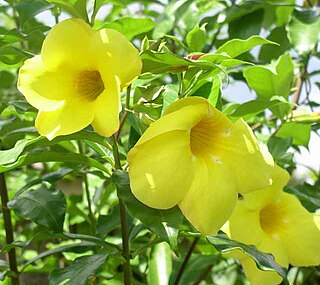
Allamanda is a genus of flowering plants in the family Apocynaceae. They are native to the Americas, where they are distributed from Mexico to Argentina. Some species are familiar as ornamental plants cultivated for their large, colorful flowers. Most species produce yellow flowers; A. blanchetii bears pink flowers. The genus name Allamanda honors the Swiss botanist and physician Frédéric-Louis Allamand (1736–1809). It is the official flower of Kuching North City Hall.

Olea is a genus of flowering plants in the family Oleaceae. It includes 12 species native to warm temperate and tropical regions of the Middle East, southern Europe, Africa, southern Asia, and Australasia. They are evergreen trees and shrubs, with small, opposite, entire leaves. The fruit is a drupe. Leaves of Olea contain trichosclereids.

Grindelia (gumweed) is a genus of plants native to the Americas belonging to the family Asteraceae. The genus was named for Latvian botanist David Hieronymus Grindel, 1776–1836.

Ocotea is a genus of flowering plants belonging to the family Lauraceae. Many are evergreen trees with lauroid leaves.

The Atlantic Coast restingas is an ecoregion of the tropical and subtropical moist broadleaf forests biome, and the South American Atlantic Forest biome. It is located along Brazil's Atlantic coast, from the country's northeast to its southeast.

Xerophyllum asphodeloides is a North American species of flowering plants in the Melanthiaceae known by the common names turkey beard, eastern turkeybeard, beartongue, grass-leaved helonias, and mountain asphodel. It is native to the eastern United States, where it occurs in the southern Appalachian Mountains from Virginia to Alabama, and also in the Pine Barrens of New Jersey.

Uvularia is a genus of flowering plants in the family Colchicaceae, which is closely related to the lily family (Liliaceae). They are commonly called bellworts, bellflowers, or merrybells. The genus name is derived from the Latin ūvula meaning "little grape", likely because of the way the flowers hang downward. For the same reason Uvularia may also refer to the similarly derived palatine uvula, which hangs down from the soft palate in the mouth. The plants are often found growing on wooded slopes or in ravines and they spread by stolons, or stoloniferous rhizomes. The plants are usually 45–60 cm (18–24 in) in height and bear one or two flowers per stem in April and May, that hang downward from the axils of the leaves.

Mendoncia velloziana is a species of flowering plant in the family Acanthaceae. It is a liana native to tropical South America, ranging from Colombia and Peru through northern, eastern, and southern Brazil to Paraguay.
Mendoncia mollis is a plant species in the family Acanthaceae. It is a liana native to west-central and southeastern Brazil.

Mendoncia is a genus of climbing plants in the family Acanthaceae.
Allamanda puberula is a species of plant in the family Apocynaceae, which is native to Brazil, typically in Caatinga, and Cerrado vegetation. This plant is cited in Flora Brasiliensis by Carl Friedrich Philipp von Martius.
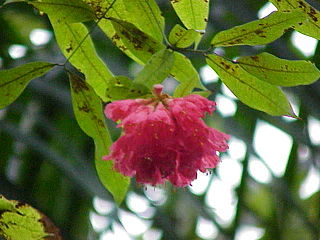
Brownea is a genus of flowering plants in the pea family (Fabaceae), subfamily Detarioideae. The genus includes about 22 species native to tropical regions of the Americas. The species are shrubs and trees growing to 20 m tall. Species range from Honduras through southern Central America and northern South America to Peru and northern Brazil, and to Trinidad and Tobago and the Windward Islands in the Caribbean. Species are typically understorey trees or shrubs in lowland tropical rain forest.
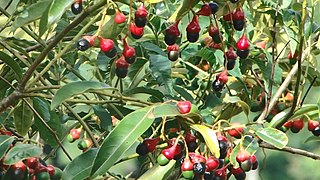
Ocotea puberula is a species of evergreen tree in the plant genus Ocotea of the family Lauraceae. It is found in Argentina, Brazil, French Guiana, Guyana, Mexico, Peru, and Suriname.
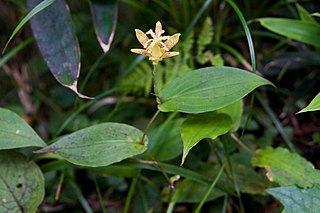
Tricyrtis latifolia, the toad lily, is an East Asian species of plants in the lily family.
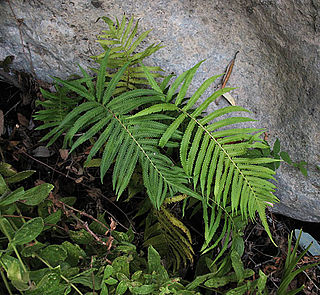
Christella puberula, synonym Thelypteris puberula, is a species of fern known by the common name showy maiden fern. The variety Ch. puberula var. sonorensis is known by the common name Sonoran maiden fern.
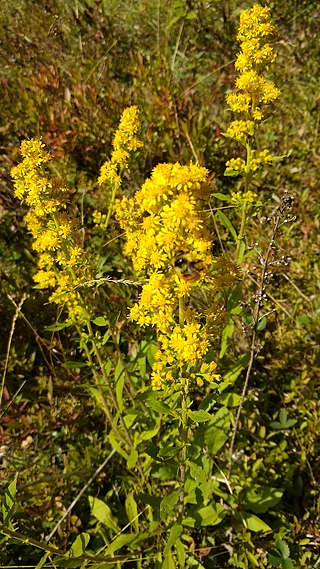
Solidago puberula, the downy goldenrod, is a plant species native to eastern North America from Nova Scotia and Ontario south to Florida and Louisiana. Two subspecies are commonly recognized:

Uvularia puberula, the mountain bellwort, is a plant species native to the eastern United States. It is common across Virginia, North and South Carolina, West Virginia, and adjacent parts of northern Georgia, eastern Tennessee, eastern Kentucky and southern Pennsylvania. Isolated populations have been found in southern Georgia, northern Alabama, southern New Jersey, and Long Island in New York State.
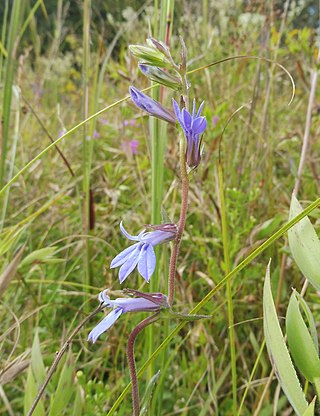
Lobelia puberula, or downy lobelia, is a perennial herbaceous wildflower in the Bellflower family (Campanulaceae) native to eastern and south central United States. It is the most common blue-flowered Lobelia in the Southeast. It grows in mesic to hydric (moist) habitats in sun or partial shade.
Pterostylis puberula, commonly known as the dwarf greenhood or snail greenhood is a species of orchid which is endemic to New Zealand. It has a rosette of pale yellowish, stalked leaves and a single silvery-white and green flower with relatively long, erect lateral sepals.

Fimbristylis puberula, commonly called hairy fimbry, is a species of flowering plant in the sedge family (Cyperaceae). It is native to North America, where it has a widespread, but patchy, distribution. The largest populations are in the Southeastern Coastal Plain and the eastern Great Plains. Its natural habitat is in prairies, savannas, and glades. It can be found on both basic and acidic soil.

















